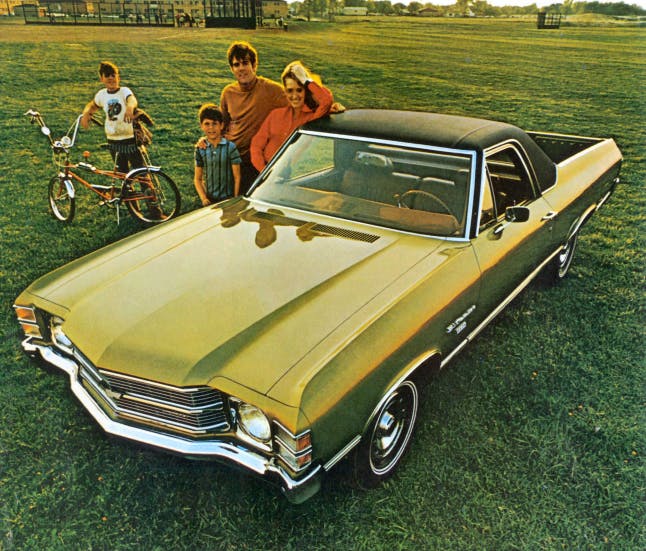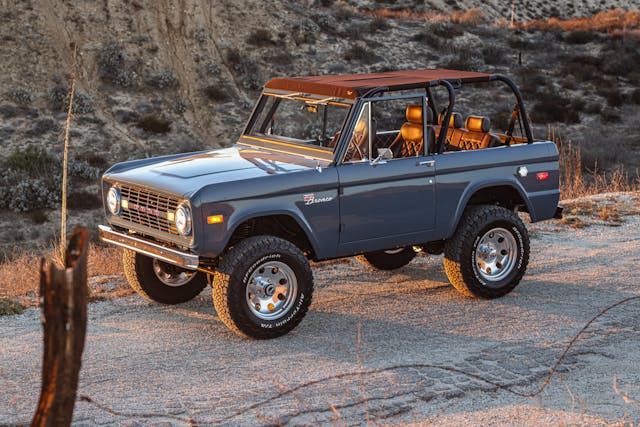These Four Pickups and SUVs Got More Expensive This Summer
Nobody should be surprised that classic trucks and SUVs, particularly 4x4s, continue to gain popularity as collectibles. Having a pickup for its utility or a 4×4 SUV to take on off-road adventures can make a lot of sense for buyers looking for a second or third vehicle—they meet needs that daily drivers simply cannot. When our valuation team tallied up the new updates to the Hagerty Price Guide, a few familiar favorites were among the list of those that increased in value the most. Here are the top four that have posted the biggest gains, based on the percentage, since this spring.
1994-1996 Ford Bronco XL

Average increase in #2 value: 25 percent
Full-size, two-door sport utilities aren’t built anymore, but they offer a great mix of maneuverability, cargo capacity, and four-person seating when needed. It’s everything people love about two-door hatchbacks but with 4×4 capability. Well, that and the fuel economy that goes with a larger rig with four driven wheels. Regardless, the last of Ford’s full-size Broncos are great examples. They offered roomy cabins and rugged drivetrains with reliable Windsor V-8s in 302- and 351-cubic-inch varieties. Their recent price increase reflects the base model XLs becoming every bit as desirable as their more luxurious XLT brethren. The added power lumbar seats, leather-wrapped steering wheel, and cruise control aren’t as important as getting behind the wheel the last of the breed.
1989-1993 Dodge Ram W250 and W350 Turbodiesel

Average increase in #2 value: 25 percent
All these years later, we’re still in the midst of the diesel power wars that were kicked off in 1989 when Dodge dropped the massive, bulletproof 5.9-liter Cummins turbodiesel into its 3/4- and 1-ton trucks. Those trucks have devoted fans, as buyers appreciate the simple mechanical injection pump and no-nonsense reliability of an early ’90s diesel. These pickups don’t have much in the way of creature comforts, but buyers are willing to pay a pretty penny for them, and it’s all because of the powertrain. A comparable 4×4 3/4-ton Dodge with a 360 V-8 will bring less than half the price.
1966-1977 Ford Bronco

Average increase in #2 Value: 18 percent
First-generation Ford Broncos were one of the first classic 4x4s to kick off the collectibility of vintage SUVs, and their prices have climbed up dramatically in the last several years. Their recent uptick is more of a correction, as they dipped a bit this spring when the market softened. They’re still down a bit year-over-year, but it wasn’t a surprise to see them bounce back as their classic lines continue to be popular for collectors who want a showroom original or a top-of-the-line restomod.
1971 Chevrolet El Camino SS 396

Increase in #2 Value: 17 percent
El Caminos have long been an affordable way to sneak into the muscle car scene, but it seems like collectors might have finally realized just how cool these car-based utility vehicles are. The 1971 El Camino used a new grille and fascia that’s almost identical to the 1972 that would follow it and close out the generation that began in 1968. For collectors, the downside of the 1971 El Camino is that it’s not a 1970 model, which had the distinct, one-year-only quad-headlight fascia which is generally regarded as more desirable. There were still two big-block options in 1971, although the legendary, 450hp LS6 454 was no longer on the table and SAE net ratings were taking a toll on power numbers. Still, an SS 396 (actually 402 cubic inches) was no slouch. If you’re considering one of Chevy’s muscular utes, you may want to hurry.



My joy is a 1989 Bronco II. Resurrected from the junk heap. Took out the unusable back seats and it functions like a small truck. Nice and short with a great turning radius. Fantastic in the woods. Fuel injected 6, AC, and cruise control, smooth riding on the highway.
My Grandfather had a 1965 IH Scout 4 X 4 that he bought new. He drove it for about 15 years. 4 cylinders, “Three on the floor”. When my generation started driving, my Dad took us out to the field in it, showed us how the shifter worked, and turned us loose. “Go practice.” When I got my license it became my primary vehicle. It stayed in the family for another 20 years. Wonderful little truck, as basic as it could possibly be. Vacuum powered wipers, manual everything. Didn’t even have a radio. The inspiration for “Shake, rattle and roll!” She got 20 mpg, you could take the roof off and I could tow my Boston Whaler. Unfortunately, a real rust bucket. By the time we sold her I think half of the fenders were made of Bondo and fiberglass. Wish I had her back.
I own a 96 F-250 power stroke diesel 4×4 and I get hit up all the time by people interested in buying it off me. I bought it 7 years ago to replace the 90 F-250 diesel that I gave to my son. Great trucks. I’m going to just keep mine because the cost of a new truck is ridiculous these days.
Hello, my name is Lia. We own a 1991 Ford F150 XLT Lariat. It was recently appraised for $26,000. It is in remarkable condition. All original. If and when we do decided to sell it, I wonder what we could realistically sell it for?
I recently spent 15k on a partial restoration of my 1995 2dr GMC Yukon. It may be more than the vehicle is worth but I really like the vehicle and would have to spend allot more to replace it with a newer vehicle that I don’t really like.
I know they are not talked about much but IH Scouts. That is my baby and I have been seeing small pockets of those collectors and wonder how big of a come back they are making; especially with the Plant starting up in South Carolina. CNN’ s Peter Valdes-Dapena put out a story March 17 2024
One word for rust, Ziebart. Growing up in Chicago with my dad’s ’69 Chrysler 300, it never had rust with slightly over 100,000 miles on it when sold. Never understood why he sold it, but probably due to low MPG. It was a boat. Loved it though. How could I not with a 440 in it?
Left off the champion of retained value, the Toyota FJ Cruiser.
One big problem with a vehicle being “rustproofed” is that most if the places that did that had ZERO idea about keeping drainage holes open, and they actually collected MORE water than stock !
Ziebart was known for that, Rusty Jones was almost as bad, even thou their dealers were given SPECIFIC INSTRUCTIONS & CHARTS to avoid the problem. Most installers were in too much of a hurry to do the job correctly, as TIME = MONEY !
AMC/Rambler had the right idea when the dipped the cars before any other paint. Our family drove them for an average of 125K & never had rust out problems, and dad drove into Chi (totally salt roads) on a daily basis. They were traded in at 4 +/- year intervals, mom got the newest one for 2 & then dad took it for another 2, our highest was traded @ 178K ! First new one I remember as a kid was a ’62 wagon, last one was a ’78 .
Correct Uncle. I had my wife’s new Mustang done there in 2014. She complained one day a few weeks later that she hears a sound like sloshing water when she stops at a stop sign. I laughed and said she was hearing things. So she took me for a drive and I listened in the passenger seat. Sure enough, I could hear the sloshing in the passenger door. Back home I investigated and pulled the plastic clip out of the drain hole in the door and a lot of water poured out. I complained at the ziebart shop and got a big apology but I feel than any company charging that kind of money should have trained people working for them. I checked the other door as well and both drain holes were clear. Both holes had been plugged by undercoating on the passenger side. I never went back to them again.
I have a 1999 SR 5 Four runner in excellent original condition (no rust) with a100k miles in Florida. Having a heck of a time trying to get collector insurance. Was only used for street shows and stuff. Any advice would be appreciated.
I bought a 73 Ford 250 in the late 80’s. It came with a camper unit which was owned by an older gentleman and his wife who did not travel anymore. It had 50 or so thousand miles on it and in vey good shape. We used the camper for a few years and sold it after buying a fifth wheel trailer. That 360 engine pulled the fifth wheel with no problem, even on steep hills. Gas mileage wasn’t great but what a great truck. It never let me down. I sold it when I traded up for a late 90’s Ford with a 351 which did the job but not like the old 360. It is still around today, the guy who bought it keeps it running somehow and It is a little rough but it but the body and engine is original.
“For collectors, the downside of the 1971 El Camino is that it’s not a 1970 model, which had the distinct, one-year-only quad-headlight fascia which is generally regarded as more desirable.” News flash, the 1968 and 1969 had quad headlights too. As far as the desirability aspect, you’ll get no argument from me.
I think he meant that 1970 was the only year that body style (used for 1970-72) had four-eyes.
Maybe I’m wrong, but I believe I read the Hagerty policy that Trucks and SUVs with Lifts or HD equipment like brush guards were not allowed.
That green 90s Bronco would be an uninsurable risk.
I have a 2005 Ford excursion. These are moving up in resale value. I would love to see an article on this.
after years of living in NY/VT/NH, I traveled to CA to scope out a move at the end of the 1970s. In Los Angles, I spotted a parked 1966 two tone BMW CS with no wipers, garbage all over the interior but a perfect body. At that point I decided to move to CA. I purchased a straight axle 1981 Toyota pu with tilt wheel and ac that over the years, I compared with my buddy’s rusting away in VT. However my forever 4×4 was destroyed by a CA wildfire, not rust. I have replaced it with a 2002 raised tacoma with more creature comforts and a rear locker. with all the awd cars on the road you might think the Ecoast would reconsider SALT. When the road to Yosemite gets too white in the winter, CHP just shuts down the road…